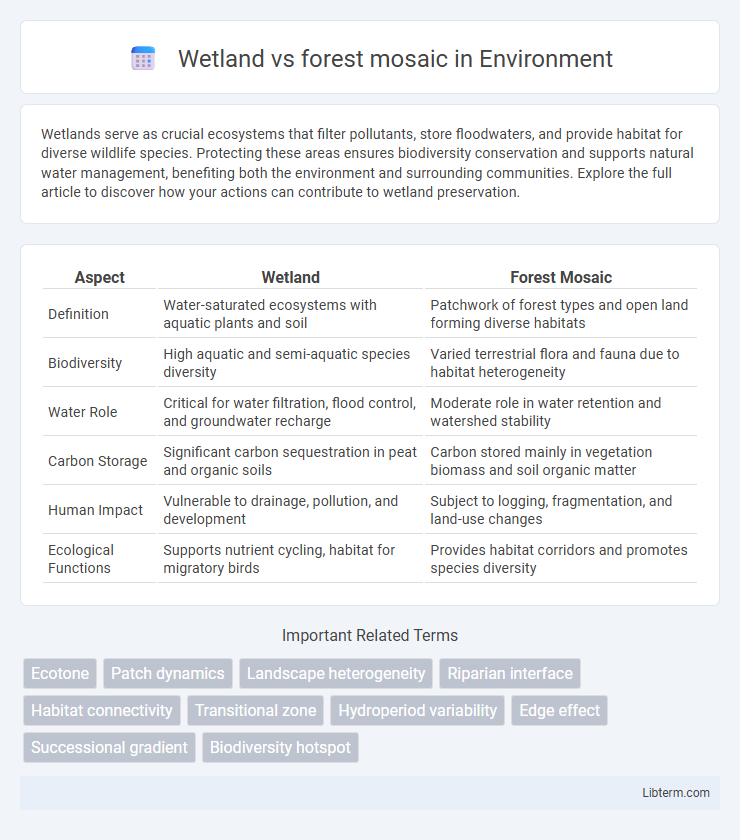Wetlands serve as crucial ecosystems that filter pollutants, store floodwaters, and provide habitat for diverse wildlife species. Protecting these areas ensures biodiversity conservation and supports natural water management, benefiting both the environment and surrounding communities. Explore the full article to discover how your actions can contribute to wetland preservation.
Table of Comparison
| Aspect | Wetland | Forest Mosaic |
|---|---|---|
| Definition | Water-saturated ecosystems with aquatic plants and soil | Patchwork of forest types and open land forming diverse habitats |
| Biodiversity | High aquatic and semi-aquatic species diversity | Varied terrestrial flora and fauna due to habitat heterogeneity |
| Water Role | Critical for water filtration, flood control, and groundwater recharge | Moderate role in water retention and watershed stability |
| Carbon Storage | Significant carbon sequestration in peat and organic soils | Carbon stored mainly in vegetation biomass and soil organic matter |
| Human Impact | Vulnerable to drainage, pollution, and development | Subject to logging, fragmentation, and land-use changes |
| Ecological Functions | Supports nutrient cycling, habitat for migratory birds | Provides habitat corridors and promotes species diversity |
Introduction to Wetland and Forest Mosaics
Wetland and forest mosaics represent complex ecosystems where diverse vegetation types coexist, creating rich habitats for a variety of wildlife. Wetlands are characterized by saturated soils and hydrophytic plants, playing critical roles in water filtration and flood control, while forest mosaics consist of interspersed patches of different forest types contributing to biodiversity and ecological resilience. The interaction between these two landscape elements enhances nutrient cycling, supports species diversity, and fosters ecological connectivity essential for sustaining ecosystem health.
Defining Wetland and Forest Ecosystems
Wetlands are ecosystems characterized by saturated soils and water-tolerant vegetation such as reeds, sedges, and mosses, playing critical roles in water filtration and habitat provision. Forest ecosystems consist of densely packed trees and understory plants adapted to varied moisture conditions, supporting high biodiversity and carbon sequestration. The mosaic formed by wetlands and forests creates diverse ecological niches, enhancing landscape heterogeneity and resilience.
Key Differences Between Wetlands and Forests
Wetlands are ecosystems characterized by saturated soils and standing water, supporting hydrophytic vegetation adapted to waterlogged conditions, whereas forests consist predominantly of dense tree populations rooted in well-drained soils. Wetlands provide critical functions such as water filtration, flood control, and carbon sequestration in anaerobic conditions, contrasting with forests that primarily serve as terrestrial carbon sinks and habitats with higher biodiversity stability. The soil composition in wetlands is typically anaerobic and rich in organic material called peat, while forest soils are aerobic with layered organic matter supporting diverse microbial communities.
Biodiversity in Wetland vs Forest Mosaics
Wetland and forest mosaics exhibit distinct biodiversity patterns driven by their unique ecological niches and hydrological regimes. Wetlands support specialized flora and fauna adapted to saturated soils and fluctuating water levels, often harboring rare amphibians, migratory birds, and aquatic invertebrates, while forest mosaics provide diverse microhabitats promoting a wider range of terrestrial mammals, birds, and understory plants. The spatial heterogeneity in forest mosaics enhances species richness through edge effects and varied vegetation structure, but wetlands are critical hotspots for endemic and vulnerable species linked to aquatic ecosystems.
Ecological Functions and Services
Wetland-forest mosaics provide critical ecological functions such as carbon sequestration, water filtration, and habitat diversity, supporting myriad species including aquatic and terrestrial wildlife. These landscapes enhance flood regulation by absorbing excess water, thus mitigating downstream impacts and maintaining hydrological balance. The interconnectedness of wetlands and forests promotes nutrient cycling and soil stabilization, crucial for sustaining ecosystem productivity and resilience.
Hydrological Dynamics in Mosaics
Wetland and forest mosaics exhibit complex hydrological dynamics driven by spatial heterogeneity and varying water retention capacities. Seasonal fluctuations in water levels and soil moisture influence nutrient cycling and vegetation patterns, creating microhabitats that support diverse ecosystems. Understanding surface and groundwater interactions in these mosaics is critical for managing flood regulation and maintaining ecological resilience.
Carbon Sequestration and Climate Impact
Wetland and forest mosaics play critical roles in carbon sequestration by capturing significant amounts of atmospheric CO2 through diverse vegetation and soil processes. Wetlands store carbon in anaerobic soils, reducing decomposition rates, while forests accumulate carbon in biomass and organic litter, making these ecosystems key components in climate regulation. The interplay between these habitats enhances overall carbon storage capacity and mitigates climate change by buffering temperature fluctuations and supporting biodiversity resilience.
Human Impacts and Land Use Challenges
Human impacts on wetland vs forest mosaic landscapes include extensive land conversion for agriculture, urban development, and infrastructure projects, leading to habitat fragmentation and biodiversity loss. Wetlands face challenges from pollution, altered hydrology, and drainage, while forest mosaics experience deforestation, selective logging, and soil degradation. Land use conflicts arise from balancing conservation needs with economic activities such as farming, fishing, and logging, demanding integrated management to sustain ecosystem services.
Conservation Strategies for Mosaic Landscapes
Conservation strategies for wetland and forest mosaics emphasize maintaining habitat connectivity to support biodiversity and ecological processes. Integrating buffer zones and ecological corridors enhances species movement and resilience against climate change impacts. Adaptive management practices, including monitoring and community engagement, are crucial to balance human activities with ecosystem preservation in these dynamic landscapes.
Future Perspectives on Wetland-Forest Interactions
Wetland-forest mosaics are critical for biodiversity conservation and climate resilience, particularly as these ecosystems provide unique habitats that support diverse species assemblages. Future research emphasizes the role of hydrological changes, carbon sequestration, and species migration patterns within these mosaics under climate change scenarios. Innovative restoration strategies integrating wetland hydrology and forest dynamics aim to enhance ecosystem services and promote adaptive resilience.
Wetland Infographic

 libterm.com
libterm.com